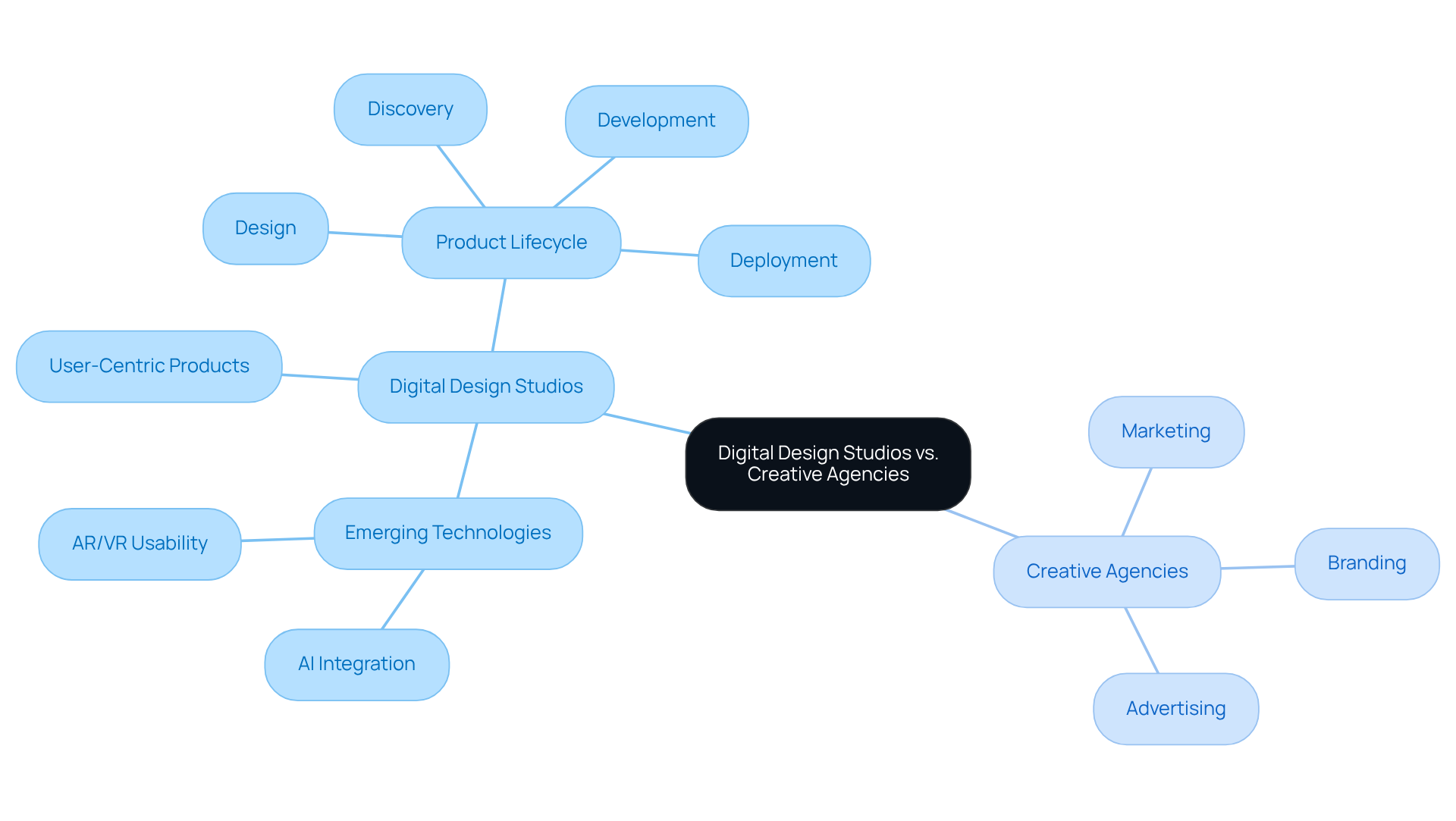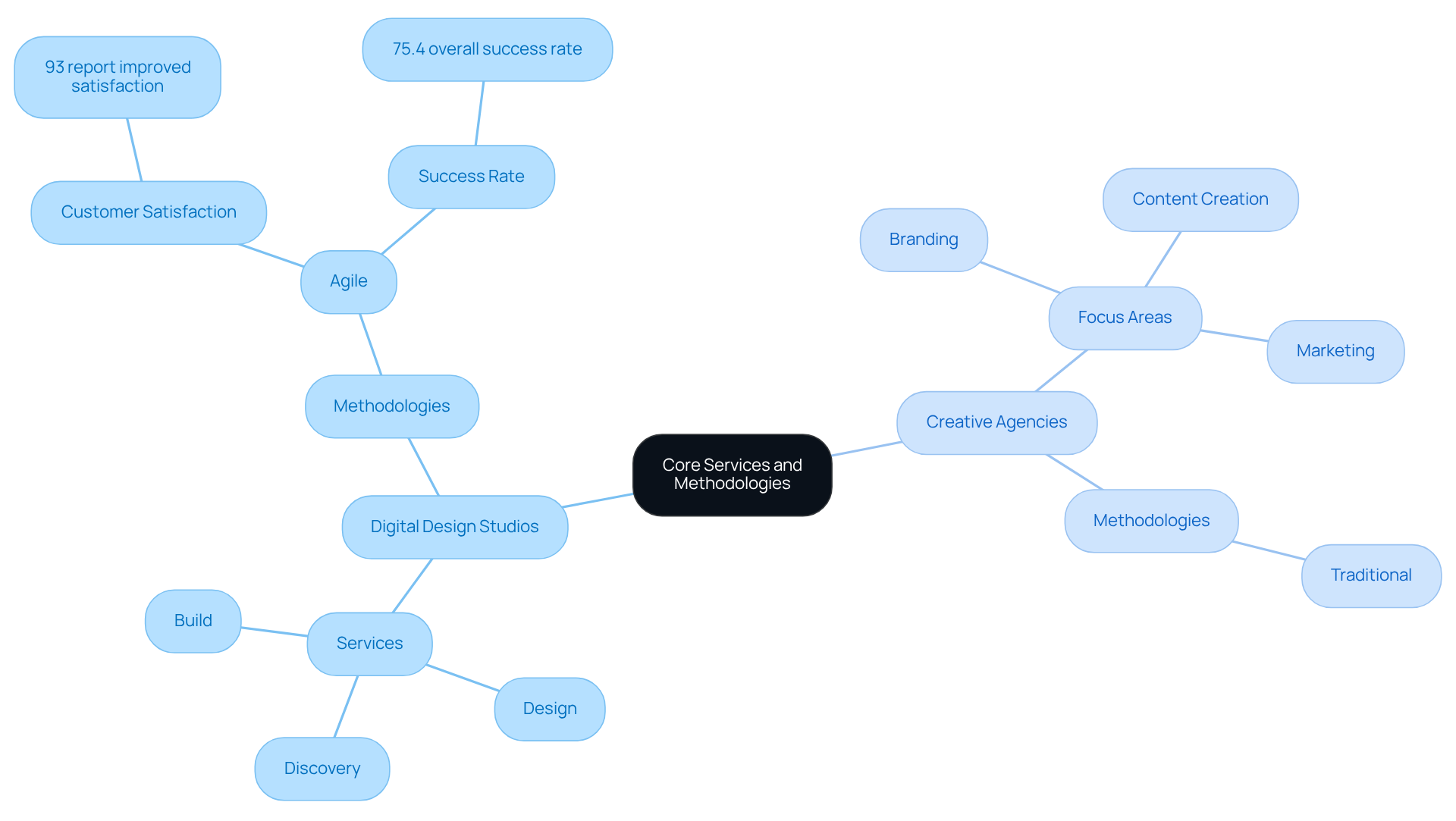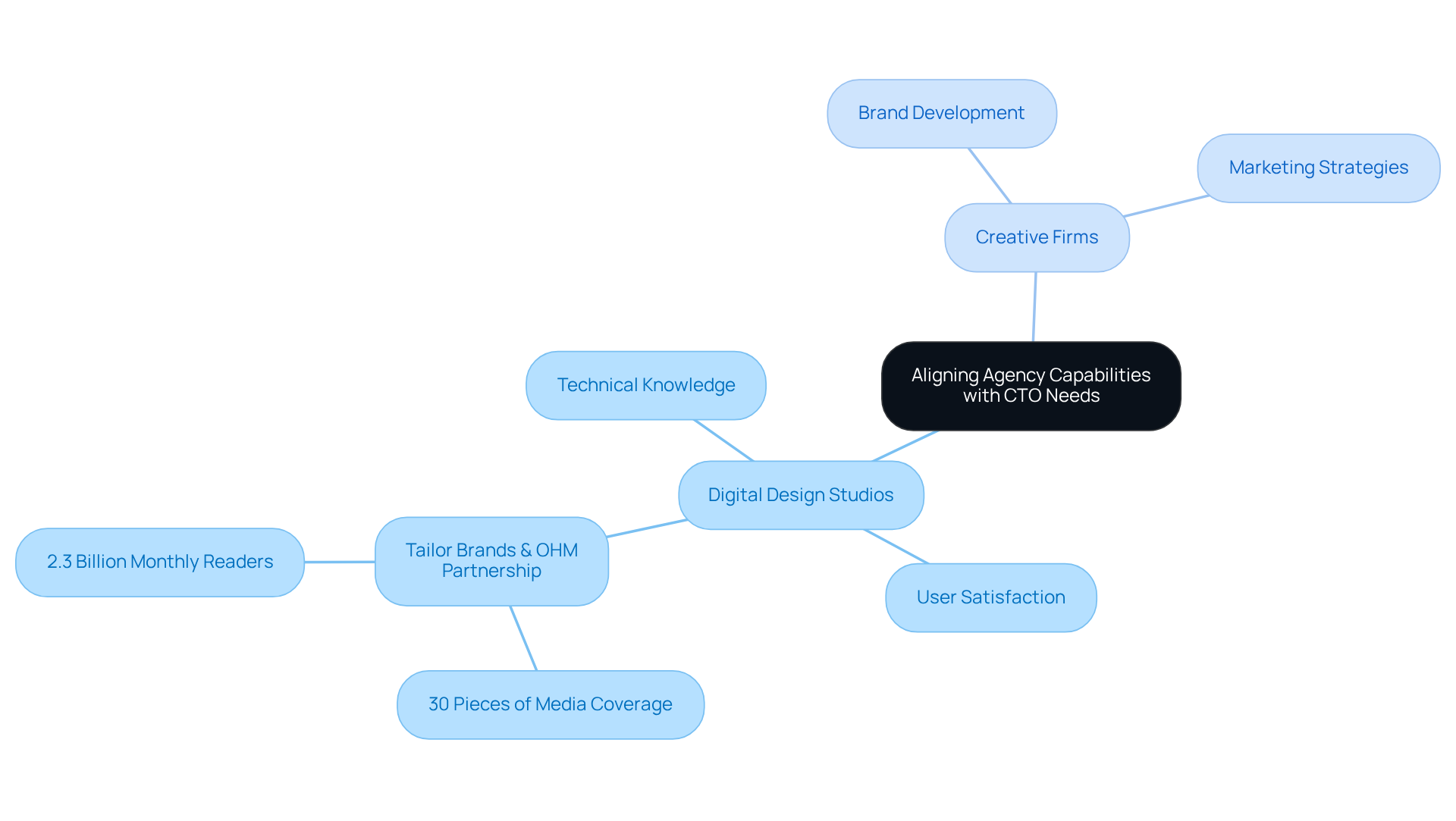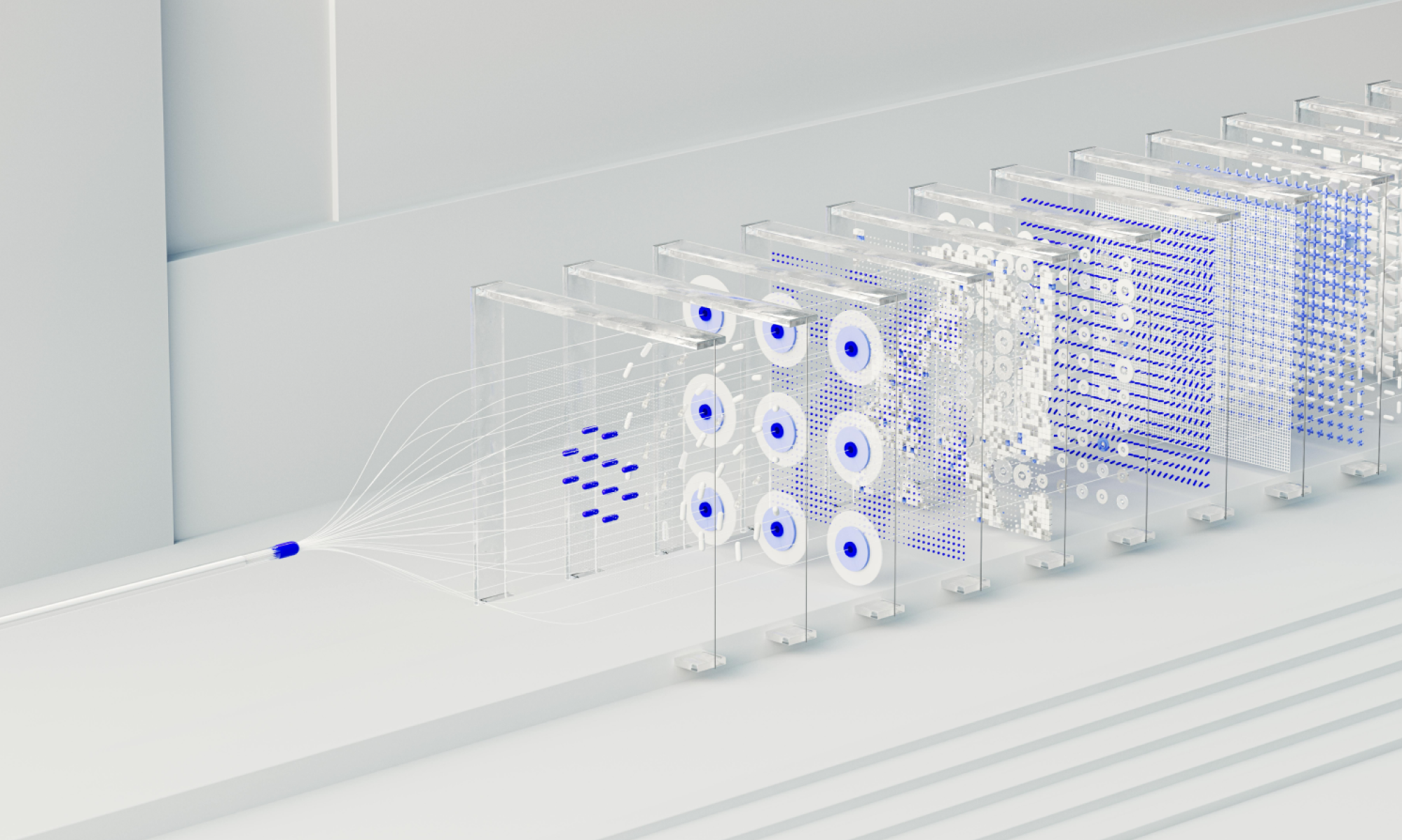AI
our blog
Comparing Digital Design Studios and Creative Agencies for CTOs

Overview
This article presents a comparison between digital design studios and creative agencies, underscoring their unique focuses and methodologies—elements that are essential for CTOs when selecting project partners.
Digital design studios are particularly adept at user-centric product development, utilizing agile methodologies that foster innovation and responsiveness. In contrast, creative agencies concentrate on branding and marketing strategies, which can significantly influence the decision-making process based on specific project requirements and overarching business objectives.
Understanding these distinctions enables CTOs to make informed choices that align with their strategic goals.
Introduction
Navigating the landscape of digital solutions presents a significant challenge for Chief Technology Officers (CTOs), especially when faced with the decision between digital design studios and creative agencies. Each type of firm possesses distinct strengths and methodologies that can profoundly influence project outcomes. This article examines the essential differences between these two entities, illustrating how their divergent emphases on user-centric design versus creative branding can impact the success of digital products. As CTOs evaluate their choices, the pressing question persists: how can they ensure that their selected partner aligns with both technical requirements and broader business objectives?
Defining Digital Design Studios and Creative Agencies
Digital design studios focus on creating user-centric digital products, frequently utilizing emerging technologies like AI to enhance functionality and improve user experience. They engage in the entire product lifecycle, from discovery and design to development and deployment. Conversely, creative firms provide a broader array of services, including branding, marketing, and advertising, with a heightened emphasis on imaginative campaigns rather than technical execution.
While both agency types seek to address client challenges, their methodologies and objectives can differ significantly. Notably, design-led companies report 50% more loyal customers, underscoring the critical role of user-focused design in driving business success. Understanding these distinctions is paramount for CTOs when selecting the right partner among digital design studios for their projects, as this choice can profoundly influence the effectiveness and usability of the final product.

Core Services and Methodologies: A Comparative Overview
A range of services, including audience research, UI/UX design, prototyping, and software development, is specialized in by digital design studios. They predominantly adopt agile methodologies, which prioritize iterative development and continuous client feedback. This enables swift modifications and enhancements throughout the product lifecycle. Such an approach not only cultivates innovation but also significantly boosts user satisfaction, as evidenced by 93% of Agile organizations reporting improved customer satisfaction.
Conversely, creative agencies typically focus on branding, content creation, and marketing strategies, often relying on traditional management methodologies that emphasize campaign execution over product development. This fundamental difference in focus can lead to varying timelines and outcomes. For example, agile methodologies have been shown to improve success rates, with Agile practitioners reporting an overall success rate of 75.4% compared to their traditional counterparts.
At Studio Graphene, our digital design studios offer a comprehensive approach to digital product development through our core services:
- Discovery
- Design
- Build
This end-to-end service model ensures that every facet of your digital journey is addressed, from initial concept to final execution, all while prioritizing regulatory and compliance readiness. As the landscape evolves, it is crucial for CTOs to align their needs with the core competencies of the agency they choose to partner with. Recognizing these distinctions can lead to more effective collaborations and ultimately drive superior business results.

Strengths and Weaknesses: Evaluating Suitability for Your Projects
Digital design studios specialize in creating customized digital solutions that prioritize client satisfaction and technical innovation. Their agile methodologies facilitate rapid prototyping and iteration, resulting in quicker time-to-market. Notably, firms that emphasize customer satisfaction report conversion rates 37% higher, underscoring the critical role of effective design in achieving success.
A prime example is Studio Graphene's creation of a user-friendly mobile app and web platform for Alchemy Wings, featuring an intuitive UI that grants access to detailed sales data through an admin portal. This initiative not only streamlined the ordering process but also integrated a delivery validation system for drivers, showcasing the studio's commitment to enhancing user satisfaction through innovative solutions.
Conversely, digital design studios may lack the comprehensive marketing and branding expertise that creative firms offer. Creative agencies, on the other hand, bring a wealth of experience in developing compelling narratives and brand identities, which can significantly boost product visibility and market penetration. Indeed, 77% of brands identify customer interactions as a key competitive differentiator.
However, the focus on creative execution may not always align with the technical demands of product development, potentially leading to miscommunication and delays. Poor user experience can lead to abandonment, lost opportunities, and reduced customer loyalty, as 88% of individuals are unlikely to return to a website after a negative interaction.
Therefore, CTOs must carefully weigh these strengths and weaknesses against their objectives to choose the right partner. Furthermore, investing in understanding target audience needs can greatly enhance interactions.

Aligning Agency Capabilities with CTO Needs and Business Goals
For CTOs, aligning organizational capabilities with business objectives is crucial for achieving successful outcomes. Digital design studios are ideal partners for the creation of innovative digital products, excelling in projects that demand profound technical knowledge and a strong focus on user satisfaction. A notable example is the partnership between Tailor Brands and OHM, which resulted in 30 pieces of media coverage, reaching an impressive 2.3 billion monthly readers. This case illustrates how effective collaboration can significantly enhance brand visibility and foster growth.
Conversely, creative firms may be better suited for initiatives that prioritize brand development and marketing strategies. A survey indicates that 23% of IT decision-makers emphasize enhancing customer experience as a key priority, underscoring the need for firms that can blend creativity with technical expertise. CTOs should meticulously assess their specific needs—whether they require technical innovation, creative storytelling, or a combination of both—to select a partner capable of effectively supporting their objectives and driving business growth. As one accomplished CTO noted, "Selecting the appropriate firm is about discovering a partner that comprehends our technical requirements and aligns with our strategic vision." This approach ensures that the chosen agency not only meets immediate project demands but also contributes to long-term business success.

Conclusion
Digital design studios and creative agencies serve distinct purposes in product development and marketing, each offering unique strengths that cater to different aspects of a business's needs. Understanding these differences is essential for CTOs aiming to select the right partner for their projects. The choice between a design studio focused on user-centric digital solutions and a creative agency specializing in branding and marketing can significantly impact the effectiveness and success of a company's initiatives.
Key insights reveal that:
- Digital design studios excel in agile methodologies, fostering innovation and user satisfaction through a comprehensive service model that spans the entire product lifecycle.
- Creative agencies bring expertise in storytelling and brand development, making them well-suited for projects that prioritize market presence and customer engagement.
By weighing these strengths and weaknesses, CTOs can make informed decisions that align with their specific objectives and drive superior business outcomes.
Ultimately, aligning agency capabilities with organizational goals is paramount. As businesses navigate an increasingly complex digital landscape, the right partnership can enhance not only product development but also overall brand visibility and customer loyalty. CTOs are encouraged to critically assess their project needs and seek collaborations that blend technical innovation with creative strategy, ensuring that their chosen agency contributes to both immediate project success and long-term business growth.









